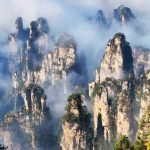There are places that look like they were painted by dreamers — and then there’s Zhangjiajie, a real-life fantasy in Hunan, China. When autumn arrives, the sandstone peaks trade their summer greens for shimmering golds, the valleys fill with ribbons of mist, and the air smells faintly of pine and rain. It’s a season where the world feels hushed and luminous — as if time itself slows to admire the view.
Where “Avatar” Found Its Sky
Long before Zhangjiajie became one of China’s most famous travel destinations, it was already a secret kingdom of stone towers and drifting clouds. But when Avatar hit the screens, people finally saw it — those floating peaks in the Hallelujah Mountains, inspired by the Zhangjiajie National Forest Park.

In autumn, this place feels even more cinematic. The cliffs blush in the golden light, forests rustle in shades of amber, and clouds swirl gently between the pillars like soft white silk. Every sunrise here could be a movie scene.
The Golden Forests of Tianzi Mountain
The Tianzi Mountain Scenic Area is often called the “Emperor of the Peaks,” and autumn might just be its royal season. The trees turn into waves of gold and crimson, flowing between the ancient rock columns. Standing at the viewing platform, you can see endless ridges glowing in sunlight — a landscape both wild and delicate, both mountain and dream.

This is where you begin to understand why Zhangjiajie is a UNESCO World Heritage Site — it’s nature’s own cathedral, filled with quiet power.
Cloud Seas and Quiet Sunrises
Zhangjiajie’s mornings in autumn are something you don’t just see — you feel. If you wake before dawn and take the cable car to Tianmen Mountain, you’ll find yourself floating above a world of mist.

The sea of clouds drifts between the peaks, sometimes covering them completely, sometimes revealing them one by one like dancers behind a curtain. When sunlight pours through the fog, everything glows gold and silver. It’s a moment that asks for silence.
Echoes of the Tujia People
Zhangjiajie isn’t only about landscapes — it’s also home to the Tujia ethnic minority, whose traditions are woven into the rhythm of the land. In autumn, villages come alive with harvest songs, handmade embroidery, and the warmth of rice wine shared among friends.
Visit a local Tujia stilt house, try a bowl of spicy cured bacon stew, or watch a wedding performance that blends music, dance, and folklore. The Tujia culture adds color to Zhangjiajie’s mountains — not just on the surface, but in spirit.
Stories Written in Stone
Every peak in Zhangjiajie feels like it has a story. Some locals say the rocks are ancient warriors frozen in time; others believe they guard the forest spirits. Scientifically, they were shaped by hundreds of millions of years of wind and water carving the sandstone — but standing there, it’s easy to believe in legends.
The nearby Laosicheng Tusi Site reveals another layer of history — once the seat of a local chieftain, now a peaceful ruin surrounded by wildflowers. It’s a place that whispers of forgotten kingdoms and old songs.
When to Visit Zhangjiajie in Autumn
The best time to travel is late September to early November, when the weather turns crisp and the forest glows in every shade of gold.
- Temperature: 10°C–20°C, perfect for hiking
- Best views: Tianzi Mountain, Yuanjiajie, Tianmen Mountain
- Secret tip: Visit right after rain — the mist makes the peaks look like they’re floating in the sky.
Travel Tips for Zhangjiajie
How to Get There
Fly into Zhangjiajie Hehua Airport or take the high-speed train to Zhangjiajie West Station. From there, buses and taxis connect you to Wulingyuan Scenic Area, the heart of the park.
Where to Stay
Stay in a mountain-view lodge or boutique inn in Wulingyuan or near the park entrance. Many offer wooden balconies with perfect sunrise views and the sound of cicadas at night.
What to Pack
Bring layers — mornings are chilly but afternoons can be warm. Comfortable hiking shoes are a must, and a light raincoat helps in misty weather.
Tickets
A Wulingyuan Park Pass (valid for several days) includes access to Zhangjiajie National Forest Park, Yuanjiajie, and Tianzi Mountain.
A Taste of Zhangjiajie
Autumn is a time of abundance in Hunan, and Zhangjiajie’s food feels like a warm hug after a mountain hike. Try:
- Tujia Bacon & Bamboo Shoots – smoky, tender, and deeply comforting.
- Sour Fish Soup – tangy, spicy, and perfect on a cool day.
- Glutinous Rice Cakes (Ciba) – chewy sweets made for sharing.
- Wild Mushroom Hotpot – earthy flavors of the forest in a bubbling pot.
Food here isn’t just for eating — it’s part of the storytelling. Every dish feels rooted in the mountains.
Why Zhangjiajie in Autumn Feels Like a Dream
There’s something gentle about Zhangjiajie in autumn. The wind feels older, the light more golden, the silence softer. Between the red leaves and floating peaks, you begin to see not only nature’s beauty but also its patience.

Zhangjiajie isn’t a place to rush through — it’s one to linger in. To breathe. To look. To listen.
And perhaps, when you finally leave, a little part of your heart will stay behind — floating with the clouds over those timeless, golden peaks.
Contact us today to craft your dream China adventure!

